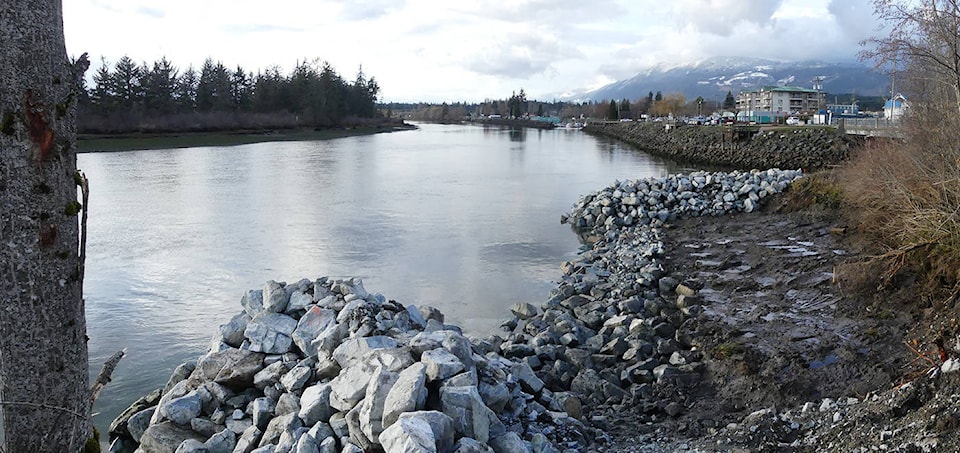BY SANDY MCRUER
Special to the News
I had heard a vague rumor about it, but when I saw all the construction at the mouth of Rogers Creek, I was concerned that all the disturbance would further reduce the ability of the creek to produce salmon. From what I had learned about protecting salmon habitat, you don’t mess with the mouth of fish creeks. And what I saw was tons of riprap being deposited at the mouth of the creek where hundreds of people go by every day. I resolved to find out what was going on, as I know I wasn’t the only person who was curious.
According to fisheries biologist Dave Clough, it is a habitat enhancement project designed to create more sedge, and brush habitat similar to what the other side of the river looks like. This habitat is crucial for salmon smolts while they are adapting to salt water.
He explained that the entire area that Catalyst Paper mill and Stamp Avenue sit on once had this kind of habitat. Thousands of tons of fill were brought in on top of it to create the mill site. In addition, the route of the river to the ocean from Clutesi Haven Marina to Dry Creek is all “hardened” with riprap (big rocks) to keep the river from eroding the stream bank as the current sweep around its last bend before tidewater.
This is part of West Coast Aquatic’s efforts to restore some of this habitat. But in order to create sedge habitat in this location, they had to keep it from being swept away by the current. Strategically placed riprap will do this. The riprap is being placed to support a small “bench” of muddy material for this purpose, and to extend out into the current above and below the bench to provide eddies for smolts to rest in.
Clough said the mud would be planted with sedges very shortly. He also mentioned that he expected that the riprap would naturally revegetate with bushes with time.
The bench construction is a pilot project. It is hoped that similar projects will follow should follow-up assessments indicate that the planting survival is high and that salmon smolts are using the new habitat.
Sheena Falconer, Executive Director of Stewardship for West Coast Aquatic, says that this $240,000 project is funded by the federal government through the Department of Fisheries and Ocean’s Recreational Fisheries Conservation Partnerships Program. She went on to say that this is the second year of a two-year project. The first year was spent planning and designing the project as well as gathering all the approvals from various agencies including permission from the city to access the site from Millstone Park, the DFO, and so on.
The planning also involved consultation with a hydrologist, fish biologists, and other resource specialists.
The aims of the project are laudable. Since the settlers came to the Alberni Valley 70 percent of the intertidal habitat has been landfilled. That has to hurt fish populations! Populations of Chinook, Sockeye, Coho have all taken a tremendous beating over the years. It is difficult enough to maintain the 30 percent that’s left of the estuary. And it’s even more difficult to re-establish habitat.
In choosing this location, they are fighting the current to establish this small bench of sedges. And this has caused the project to be extremely expensive.
However, it was the only location that the proponents could find where something like this could be tried. Upstream are Rogers Creek, Victoria Quay, and Clutesi Haven Marina. And downstream is all mill property to tidewater. And the city was agreeable to allowing access through Millstone Park beside the mouth of Roger Creek.
It remains to be seen if the increase in fish populations we will see in the future will be enough to pay for the work that is being done here. It is possible. The riprap will be there for thousands of years. And Roger Creek will survive this minor insult.
